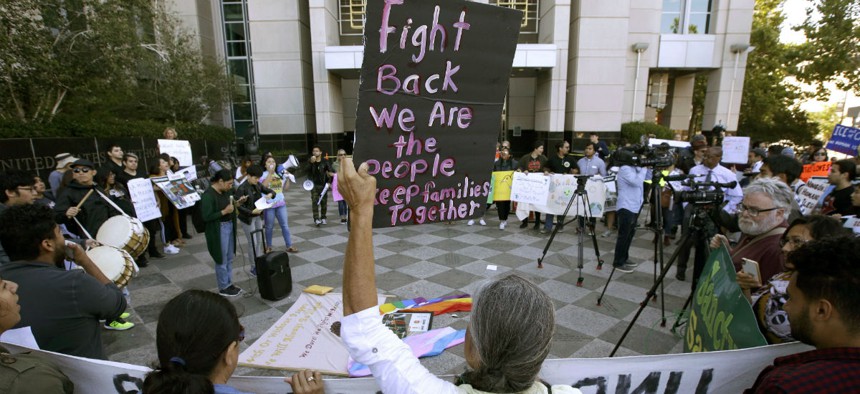ICE Enforcement Numbers Show States Where Deportation Most Likely
Lower priority is assigned to states and cities that offer sanctuary to undocumented immigrants, study finds.
April 11, the same day news broke that President Trump was considering directing Immigration and Customs Enforcement to move undocumented border-crossers to sanctuary cities and Democratic Party strongholds, a research group released numbers dramatizing the current regional priorities of ICE.
“A Ten-Fold Difference in Odds of ICE Enforcement Depending Upon Where You Live,” is the title of the study released last week by the nonprofit, nonpartisan Transactional Records Access Clearinghouse research group located at Syracuse University.
Noting that ICE clearly lacks the resources to track down the estimated 11 million unauthorized immigrants around the country, TRAC’s researchers examined ICE’s case-by-case records in two categories: “custodial arrests,” in which individuals already arrested by a law enforcement agency are transferred to ICE as part of the “Secure Communities” program, and “community arrests,” in which ICE arrests an individual it believes is deportable at his or her home, or when that person gets involved with another agency, such as U.S. Citizenship and Immigration Services, or a court.
The new data obtained under the Freedom of Information Act show that the first approach, under the Secure Communities program, accounts for four out every five removals of individuals from the nation’s interior. “As part of this program, ICE often issues detainers asking other law enforcement agencies—local, state or federal—to hold individuals longer, to give ICE time to take them into custody. This program has encountered resistance in many communities and has led to passage of ‘sanctuary’ provisions limiting cooperation with ICE enforcement officers,” the analysts wrote.
That means a “person's odds of being arrested and deported vary greatly depending upon where he or she lives,” TRAC wrote. “The odds of [secure communities] deportations and ICE community arrests showed up to a ten-fold difference among the states. Living in a sanctuary jurisdiction often reduced these odds.”
For example, living in Los Angeles, New York City, or Chicago (Cook County) meant a much lower chance of deportation under Secure Communities, compared with residing in Dallas, Texas; Orange County, California; or Phoenix, Arizona (Maricopa County), the study found.
As for the scale of the challenge, TRAC found that the Secure Communities program resulted in 77,858 deportations during fiscal 2018. Compared with the estimated total number of unauthorized individuals residing in this country, this means 6.9 removals for every 1,000 individuals, a 0.69 percent deportation rate, the report said.
Isolating the areas where the stepped-up deportations took place, the group used available figures from fiscal 2017 up to May 2018 and found a total of 67,237 community arrests. Out of the universe of 11 million, that amounted to 6 arrests for every 1,000 unauthorized people, or 0.60 percent.
“Whatever the faults may be in our current immigration laws, the manner in which these laws are being administered has resulted in a country in which the location of your home has an outsize influence on whether ICE will target you,” TRAC concluded. “This has not resulted in either an efficient or effective system for achieving this administration's stated policies or its goals. Nor can such a system be described as meeting this nation's commitment to the rule of law—a principle that all people and institutions are subject to and accountable to laws that are fairly applied and enforced.”




